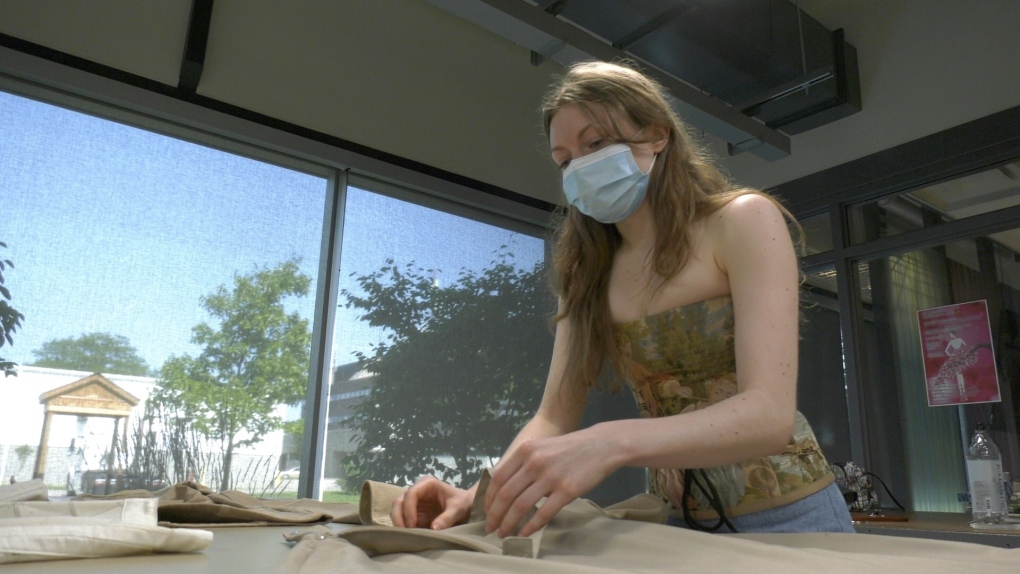Young designer transforms unwanted goods into fashion pieces
Upcoming fashion designer Maddie Bevacqua is looking to highlight the importance of sustainability by turning unwanted materials into fashionable clothing.
“The reason I got into fashion was because I didn’t want to support fast fashion brands anymore,” says the 23-year-old designer.
The fashion industry is one of the largest polluting industries in the world, even ahead of the transportation industry. One of the main culprits is fast fashion — mass production of cheap and replaceable clothes that come with an environmental cost.
“The second biggest polluters in landfills is the textiles and garments. So it’s a huge problem right now,” says Elaine Chatwood, coordinator of the St. Clair College Fashion Design program.
Bevacqua’s pieces sourced from recycled materials won her the top designer award at St. Clair College’s 2021 Atelier Fashion Show which came with a $1,000 scholarship.
The recent St. Clair graduate created her one-of-kind garments using tablecloths, curtains and tapestries she found at local thrift stores.
“I don’t like taking like a perfect tapestry. I like to take something that’s damaged and might not be used for its original purpose and give it new purpose,” says Bevacqua.
 Designer Maddie Bevacqua at St.Clair College in Windsor, Ont. on Monday, July 26, 2021. (Sijia Liu/CTV Windsor)
Designer Maddie Bevacqua at St.Clair College in Windsor, Ont. on Monday, July 26, 2021. (Sijia Liu/CTV Windsor)
The process of creating the pieces takes time. Bevacqua often searches through local thrift stores and online markets for months before finding suitable materials. She then begins designing her garments and making them by hand.
“The hardest part is cutting my fabrics. I’m really scared that I’m going to screw up. Once I screw up on a certain material, I can’t get a new one. So I’ll have to make a solution,” she says.
Chatwood says the sustainable fashion is growing in popularity with younger generation as they become more conscious shoppers. To break the fast fashion habit, Chatwood suggests consumers think twice before purchasing an item.
“You should ask a few questions. First of all, do you need this? Secondly, what is the fabric? f possible always buy organic cotton and recycled polyester,” she suggests.
When shopping, Chatwood says the seams can reveal a lot about the quality of clothing.
“Look inside the garments at the seams. If the garment isn’t sown very well and the seams allowances are really small, after one or two washes it’s going to frail.”
Finally, she suggests consumers learn basic sewing skills.
“Learn how to sow a button on, fix a zipper and actually owning a sewing machine again,” Chatwood says. “It’s a great trend learning how to fix your own items.”
CTVNews.ca Top Stories

Lack of detention space could force CBSA to release detainees, internal memo warns
The Canada Border Services Agency is scrambling to find space to hold high-risk detainees that are set to be transferred from provincial jails in June.
BREAKING American millionaire Jonathan Lehrer denied bail after being charged with killing Canadian couple
American millionaire Jonathan Lehrer, one of two men charged in the killings of a Canadian couple in Dominica, has been denied bail.
BREAKING Allman Brothers Band co-founder and legendary guitarist Dickey Betts dies at 80
Guitar legend Dickey Betts, who co-founded the Allman Brothers Band and wrote their biggest hit, 'Ramblin' Man,' has died. He was 80.
Trend Line Anger, pessimism towards federal government reach six-year high: Nanos survey
Most Canadians in March reported feeling angry or pessimistic towards the federal government than at any point in the last six years, according to a survey by Nanos Research.
Police make arrests in grandparent scam that defrauded victims out of $739K
Ontario Provincial Police say they have 'disrupted' an organized crime group that allegedly used an emergency grandparent scam to defraud seniors across Canada out of hundreds of thousands of dollars.
Taylor Swift's new album allegedly 'leaked' on social media and it's causing a frenzy
A Google Drive link allegedly containing 17 tracks that are purportedly from Swift's eagerly awaited "The Tortured Poets Department" album has been making the rounds on the internet in the past day and people are equal parts mad, sad and happy about it.
Motion to allow keffiyehs at Ontario legislature fails
A motion to reverse a ban on the keffiyeh within Queen’s Park failed to receive unanimous consent Thursday just moments after Ontario Premier Doug Ford reiterated his view that prohibiting the garment in the House is divisive.
What does it mean to be 'house poor' and how can you avoid it?
The journey to home ownership can be exciting, but personal finance columnist Christopher Liew warns about the trappings of becoming 'house poor' -- where an overwhelming portion of your income is devoured by housing costs. Liew offers some practical strategies to maintain better financial health while owning a home.
Calgary man charged with manslaughter in death of toddler
Calgary police say Winston Campbell, 45, has been charged in the death of a two-year-old girl in 2022.

































